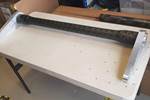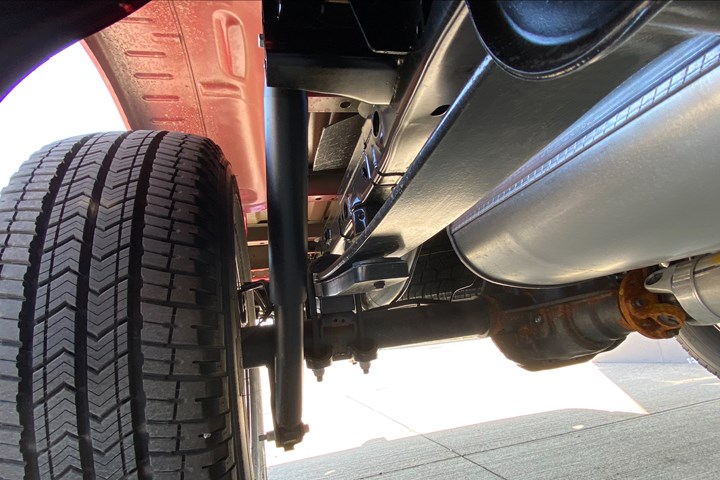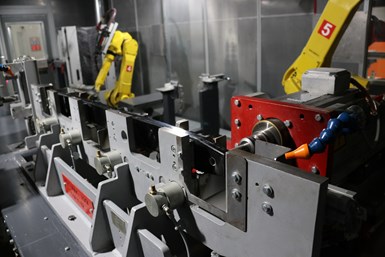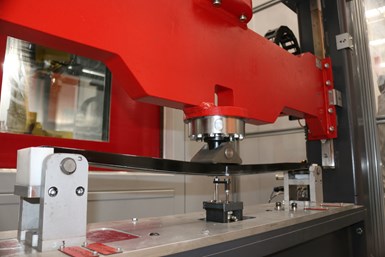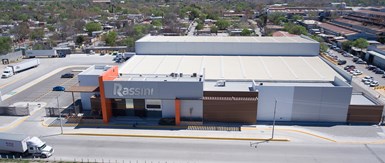Rassini’s 1+C Hybrid leaf spring features a single steel parabolic main plate and a flat glass fiber composite helper plate to provide suspension on the rear wheels of the Ford F-150 pickup truck.
Photo Credit, all images: Rassini
In 2016, Ford Motor Co. (Dearborn, Mich., U.S.) challenged Rassini International (Plymouth, Mich., U.S.) with the task of taking weight out of the rear suspension of the F-150 pickup, the carmaker’s flagship and iconic truck. Rassini, North America’s largest supplier of leaf springs and other suspension components, presented Ford with several options to get this done, but favored a solution that would integrate traditional steel leaf springs with a composite “helper” — a multi-material solution that represents a significant growth opportunity for the autocomposites end market.
Brent Collyer, VP engineering, leaf springs, and R&D director for lightweighting at Rassini, says the company’s place in the automotive supply chain makes it a natural partner for OEMs looking for innovative solutions. “When Ford engineering is looking at what they’re going to do with next-generation products for suspension needs of leaf springs, they come to us first,” Collyer says. “They had some very aggressive lightweight targets for their chassis on the next generation of F-150 trucks … and they wanted to know what ideas we had.”
The options Rassini presented to Ford were a logical extension of the evolution of the leaf spring spanning the history of motorized transport. Early leaf spring designs relied on the use of multiple constant-thickness steel plates that were stacked and bound together in a pack, with plates engaged successively (top to bottom) as payload increased. Over the years, as steel quality increased, the number of plates in the pack was gradually reduced, as they were able to withstand the same load with fewer plates.
Rassini manufactures the glass fiber/epoxy helper plates for the 1+C Hybrid leaf spring in three highly automated HP-RTM cells in Piedras Negras, Mexico. Each cell uses a 10-cavity mold and the entire facility produces more than 800,000 composite helper plates per year.
The Hotchkiss suspension is primarily used on truck and van applications where the vehicle is designed to be operated with different payload and trailer tow conditions. The typical leaf spring for a full-size pickup truck features a 2+1 design, comprising two curved steel main plates tied together, and a flat steel helper plate attached at the bottom of the main plates. The main plates are about 2.0 meters long and 70 millimeters wide, and when in a free, unstressed position, are curved up at the ends in a wide “U” shape; the helper plate is typically flat in its free position.
The 2+1 spring structure is attached by the ends of the main plate to the truck frame; there is a leaf spring mounted inboard of each of the rear wheels, with the middle of the spring rigidly connected to a solid rear axle. The main plates do most of the work in the suspension system, but the helper plate is engaged when the vehicle becomes loaded with payload and during large suspension articulations from road loads. Therefore, the helper plate is the last structural member to be engaged when the suspension is loaded. This is not trivial. A Hotchkiss suspension on a vehicle like the F-150, must withstand loads and moments from six degrees of freedom (6D0F): three load cases being vertical, longitudinal, lateral, as well as three moment cases roll, pitch and yaw.
“The leaf spring is a multi-functional suspension component that is not only taking care of the spring requirements from a vertical ride load case,” Collyer says, “but the spring is actually also a beam element that connects the axle to the vehicle, such that the lateral and longitudinal loads/moments are also being reacted by the spring.”
Rassini’s multi-material leaf spring for the 2021 MY F-150 represents a further evolution of the 2+1 design and revolves around two weight-saving innovations. Dubbed 1+C, it features a single steel main plate and a composite helper plate. Each of these parts accounts for about half of the weight saved in the entire structure. The single steel main plate features a parabolic taper that optimizes material performance and provides much of the load-bearing required. The glass fiber-reinforced plastic (GFRP) helper plate engages during heavy load conditions.
Composite helper plates are finished via trim and drill in a CNC machine prior to assembly with the steel main plate. Rassini is North America’s largest manufacturer of leaf spring components and has expansion capacity at its Mexico plant to produce additional composite helper plates.
“We could do a full composite spring and we can do a full steel spring, or we can do a mix, and that is what Ford chose in this particular vehicle,” Collyer says. “The main leaf remains steel and the helper leaf becomes composite.” Collyer emphasizes that the parabolic taper thickness of the high-strength steel provided significant strength and weight savings in its own right. “With this design approach, the spring beam is fully optimized for stress distribution,” he says. “We’re using our most advanced materials available to achieve the lightest weight possible, so basically we have completely optimized the design and usage of the materials.”
M&P considerations
Collyer says Rassini considered several materials options in designing the composite helper plate, but ultimately landed on a non-crimp fabric E-glass provided by SGL Carbon (Wackersdorf, Germany) infused with Westlake Epoxy’s (formerly Hexion, Duisburg, Germany) EPIKOTE resin TRAC 06150 epoxy resin system. Carbon fiber was considered, Collyer reports, but says the cost of the material did not support the business case.
With materials chosen, Rassini then had to finalize the design of the composite helper plate. The challenge here revolved around the fact that GFRP’s modulus of elasticity is much less than steel’s modulus of elasticity, which is directly proportional to the spring rate. “We need the helper to have the same spring rate as the steel version,” says Collyer, “so we have to make it thicker from GFRP to get its spring rate load deflection curve to match.”
Modulus performance of the composite material also drove the design preference toward the multi-material spring choice. If the spring was made from all-composite material, the suspension would require architectural changes to accommodate a wider GFRP main plate. Collyer explains: “The reason the steel spring is in the main plate is because it’s required for lateral loading. If you have a composite in the main plate at the same width as the steel spring, due to the low modulus of the composite material, the suspension would have less lateral stiffness. Thus, we could make the main plate out of composite, but we would have to make it wider to compensate and maintain the vehicle’s lateral performance. That means more complexity to the suspension architecture to package a wider spring.”
Each composite helper plate Rassini manufactures undergoes load testing prior to delivery to Ford. The composite helper plate, combined with advances in materials and design in the steel main plate, allowed Ford to remove 16 kilograms of mass from its F-150 pickup truck.
The final composite helper plate that Rassini developed is 1.0 meter long, 70 millimeters wide and 30 millimeters thick — about 1.7 times the thickness of its steel predecessor, but still 53% lighter. Combined with weight savings provided by optimization of the main plate design, Rassini achieved for Ford a total weight savings of approximately 16 kilograms per vehicle. The composite helper plate, Collyer admits, comes at a cost premium, but with the weight savings consideration, it was a premium Ford could accept. This is supportive of reduced greenhouse gases (GHG) and more stringent CAFE and emissions standards progression for the future. “The market is starting to accept certain dollar-per-kilogram premiums for these weight-saving opportunities,” Collyer says, “and when you can do it in one project and get 16 kilograms, it becomes a very attractive business case.”
The next challenge, says Collyer, was to develop a manufacturing process that could meet the high production volumes of the F-150 product line. Collyer says initial product development and prototyping used hand-laid prepreg materials. However, as Rassini considered mass production, it had to get into a high-volume, automated, highly repeatable process, and thus chose high-pressure resin transfer molding (HP-RTM). “For this particular project, because of the volume, HP-RTM presented the best business case,” Collyer says. “Prepregs are viable for 100,000 springs a year or less. With the high volume of this program, we needed something more than that. Once you get over 100,000 units per year, HP-RTM starts looking attractive.”
Working with moldmaker Alpex Technologies GmbH (Mils bei Hall, Austria) and machinery suppliers FILL Gesellschaft GmbH (Gurten, Austria), Hennecke Inc. (Bridgeville, Pa., U.S.) and Engel (York, Pa., U.S.), Rassini developed and installed three highly automated HP-RTM cells at its newest plant, in Piedras Negras, Coahuila, Mexico, just across the Rio Grande River and between the Texas towns of Laredo and Del Rio. Each of the three HP-RTM cells operates a 10-cavity mold at a rate of about 28,000-30,000 cycles per year, for a total capacity of 840,000-900,000 helper plates per year. Each composite helper plate is also load tested prior to shipment to Ford.
Rassini built this 52,000-square-foot plant in 2018 in Piedras Negras, Coahuila, Mexico, for the sole purpose of manufacturing composite helper plates for the 1+C Hybrid leaf spring. The highly automated manufacturing requires touch labor only for loading glass fiber rolls and for unloading finished parts.
The Piedras Negras facility represents, arguably, the future of composites manufacturing for automotive applications. The 52,000-square-foot plant was commissioned in March 2018 when the first of the three HP-RTM lines began operation. By March 2020, all three lines were up and running, with room for a fourth line as needed. And the facility itself has enough land around it to nearly double its size. Collyer says the composite helper plates are currently the only parts made at the plant, and with the high degree of automation, the operators typically interact with equipment at the beginning of the process (loading NCF rolls) and at the end (pulling finished parts).
How does this 16-kilogram weight savings translate into tangible benefits for Ford and its customers? Collyer says Rassini cannot share specific data from Ford, but it can share hypothetical case data about application of lightweighting a vehicle like the pickup truck. For example, assume that a gas-powered vehicle averages 20 miles per gallon over its lifetime, with the average vehicle lifetime being 150,000 miles and the number of vehicles using the lightweight leaf spring being about 2.5 million units. A 16-kilogram weight savings for that fleet of vehicles saves an estimated 758,000 tonnes of CO2 emissions and 322 million liters of fuel over the fleet lifetime.
The Ford F-150 is built on the company’s P702 platform, which is expected to use the Rassini 1+C Hybrid leaf spring throughout its life.
Rassini’s innovation designing and developing the F-150 leaf spring has not gone unnoticed. The company was recognized with awards at the 2021 SPE Automotive Composites Conference and Exposition (ACCE) and at the 2021 SPE Innovation Awards Competition & Gala, winning in the Chassis Hardware category and the Grand Award. Rassini also received a 2021 Altair Enlightenment Award for the multi-material leaf spring assembly.
Rassini notes that now it has successfully executed this exciting composite lightweight project, there is a realization that this technology can be expanded to other products. Collyer says the company is open to pursue other developments for lightweighting that the industry may need.
Related Content
From the CW Archives: Fast-cure epoxies for automotive fabrication
Sara Black’s 2015 report on the development of snap-cure epoxies for automotive manufacturing still resonates today.
Read MoreCarbon fiber satellite arm reduces weight, simplifies assembly onto naval vessels
Satcom developer EM Solutions partnered with ACS Australia to replace an aluminum arm design with a 65% lighter, one-piece, corrosion-resistant carbon fiber/epoxy alternative.
Read MoreTCR Composites introduces TR1116 snap-cure epoxy prepreg resin system
Designed for press-cure applications, the resin system is highlighted for its snap-cure capability and tailored properties.
Read MoreNanopoxy, Nione jointly develop nanostructured epoxy resin
Epoxies featuring nanometric niobium pentoxide particles promote toughness, UV radiation resistance and other performance gains.
Read MoreRead Next
Carbon fiber in automotive: At a dead end?
For decades, carbon fiber has failed to break through into mainstream automotive applications as the composites industry has hoped it would. Alternative composite applications suggest future opportunities still remain bright.
Read MoreComposite-metal anti-roll bars make headway for lightweight automotive suspension systems
The LiMeCH project, led by the AMRC, Tinsley Bridge and Performance Engineered Solutions, developed filament-wound CFRP-metallic roll bar prototypes, with additional advances in joint bonding the hybrid materials.
Read MoreModeling and characterization of crushable composite structures
How the predictive tool “CZone” is applied to simulate the axial crushing response of composites, providing valuable insights into their use for motorsport applications.
Read More



